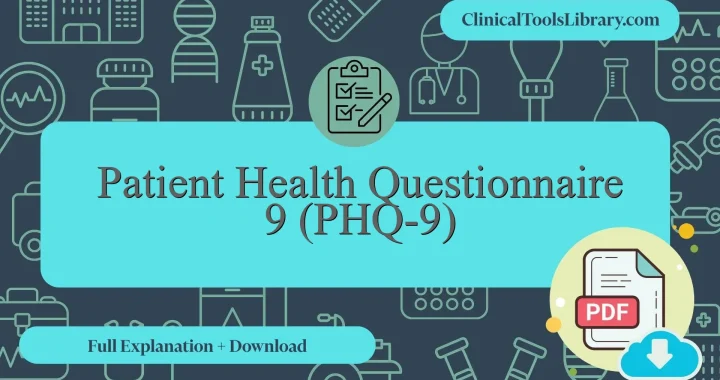In this article, we explain everything you need to know about the Positive and Negative Syndrome Scale. We will cover the aspects it evaluates, the target population, a detailed step-by-step explanation, and how to interpret its results. Additionally, we will dive into the scientific evidence supporting this tool (diagnostic sensitivity and specificity) in clinical assessment. You will also find official and unofficial sources available for download in PDF format.
What does the Positive and Negative Syndrome Scale assess?
The Positive and Negative Syndrome Scale (PANSS) is a standardized clinical tool used primarily to assess the severity of symptoms associated with schizophrenia. It evaluates three dimensions: positive symptoms, negative symptoms, and general psychopathology, providing a comprehensive profile of the patient’s condition. The main purpose of the PANSS is to quantify the extent and intensity of these symptoms to guide treatment decisions and monitor therapeutic efficacy. Clinicians and researchers often refer to the PANSS scale questionnaire PDF or PANSS scale scoring interpretation documents to ensure accurate and consistent application of the scale. Accessibility to resources such as the PANSS scale online and PANSS scale scoring pdf facilitates standardized assessment protocols in both clinical and research settings.
For which type of patients or populations is the Positive and Negative Syndrome Scale intended?
The Positive and Negative Syndrome Scale (PANSS) is primarily indicated for patients diagnosed with schizophrenia to assess the severity of positive symptoms (such as hallucinations and delusions), negative symptoms (including social withdrawal and blunted affect), and general psychopathology. It is most useful within clinical settings focused on symptom monitoring, treatment planning, and evaluating therapeutic response over time. The tool facilitates standardized symptom quantification, particularly in research trials and routine psychiatric evaluations. Clinicians often refer to the PANSS scale scoring interpretation to guide differential assessments and measure changes across treatment phases. Its application is also supported by resources like the PANSS scale questionnaire PDF and the PANSS scale scoring pdf, which provide structured guidance for accurate administration and scoring consistency.
Step-by-Step Explanation of the Positive and Negative Syndrome Scale
The Positive and Negative Syndrome Scale (PANSS) consists of 30 items designed to assess symptom severity in patients with schizophrenia. The scale is divided into three subscales: Positive Symptoms (7 items), Negative Symptoms (7 items), and General Psychopathology (16 items). Each item is rated on a 7-point Likert scale ranging from 1 (absent) to 7 (extreme), based on a structured clinical interview. The clinician systematically evaluates observable behaviors and patient reports, focusing on symptoms such as hallucinations, delusions, blunted affect, and social withdrawal. Responses are scored individually, and total scores are computed for each subscale to quantify symptom severity accurately. Proper administration requires training to ensure reliability and consistency in ratings across different clinicians.
Downloadable Positive and Negative Syndrome Scale PDF: PANSS Questionnaire & Scoring Guide PDF
Below are downloadable resources available in both the original language and English versions of the Positive and Negative Syndrome Scale PDF. These documents include the PANSS scale questionnaire PDF and comprehensive guides for PANSS scale scoring interpretation, facilitating accurate assessment for conditions such as schizophrenia. Healthcare professionals will find the PANSS scale download files useful for clinical and research purposes, ensuring standardized evaluation practices are maintained.
How to interpret the results of the Positive and Negative Syndrome Scale?
The Positive and Negative Syndrome Scale (PANSS) is a standardized tool used to assess the severity of schizophrenia symptoms by generating separate scores for positive, negative, and general psychopathology domains. Interpretation involves comparing individual subscores to established reference ranges, typically with positive and negative scores ranging from 7 to 49, and general psychopathology from 16 to 112. A higher score indicates increased symptom severity; for example, a positive symptom score above 21 suggests prominent hallucinations or delusions, while negative scores exceeding 20 reflect notable affective flattening or social withdrawal. Calculating the total PANSS score using the formula Total Score = Positive + Negative + General Psychopathology aids in quantifying overall illness burden. Clinically, these results inform treatment adjustments, prognosis, and monitoring therapeutic response, enabling healthcare professionals to tailor interventions effectively based on symptom progression or remission.
What scientific evidence supports the Positive and Negative Syndrome Scale ?
Developed in 1987 by Kay, Fiszbein, and Opler, the Positive and Negative Syndrome Scale (PANSS) has been extensively validated as a reliable tool for assessing symptom severity in schizophrenia. Its psychometric properties have been confirmed through numerous studies demonstrating high interrater reliability and internal consistency. The scale’s validity is supported by its correlation with other established measures of psychopathology and functional outcomes. Longitudinal research indicates that PANSS scores effectively track changes in clinical status, thereby serving as a sensitive measure in both pharmacological trials and clinical settings. The test’s factor structure has been replicated across diverse populations, reinforcing its applicability in evaluating separate symptom dimensions, including positive, negative, and general psychopathology in psychotic disorders.
Diagnostic Accuracy: Sensitivity and Specificity of the Positive and Negative Syndrome Scale
The Positive and Negative Syndrome Scale (PANSS) demonstrates variable sensitivity and specificity depending on the clinical context and cut-off scores used. Studies have reported sensitivity values ranging from approximately 0.70 to 0.85 in detecting acute symptom exacerbations in schizophrenia, while specificity typically falls between 0.65 and 0.80 when distinguishing between psychotic and non-psychotic disorders. The scale’s sensitivity to changes in symptom severity makes it a valuable tool for monitoring treatment response, although its specificity may be influenced by overlapping symptom profiles in related psychiatric conditions. Overall, the PANSS provides a balanced measure of both positive and negative symptom domains, reflecting its utility in both clinical and research settings.
Related Scales or Questionnaires
The Positive and Negative Syndrome Scale (PANSS) is closely comparable to several other clinical tools, such as the Brief Psychiatric Rating Scale (BPRS), the Scale for the Assessment of Positive Symptoms (SAPS), and the Scale for the Assessment of Negative Symptoms (SANS). While the BPRS provides a broader overview of psychiatric symptoms, it is less specific for schizophrenia than the PANSS. SAPS and SANS separate positive and negative symptom assessment, which may increase sensitivity but complicate integrated scoring, in contrast to PANSS’s combined approach. Each of these scales, detailed on ClinicalToolsLibrary.com, offers distinct advantages in terms of clinical focus, ease of administration, and interpretability. For instance, the PANSS scale questionnaire PDF and scoring interpretation are designed for use in both research and clinical settings, balancing comprehensiveness and usability. However, its complexity and time required for administration can be seen as disadvantages compared to shorter tools like the panss-6 scale pdf download. All these instruments—and their clinical applications—are thoroughly explained and accessible for download on our website to support informed tool selection and implementation.




